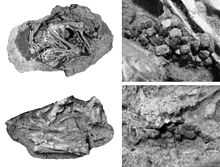Gasparinisaura
| Gasparinisaura Temporal range: 85Ma | |
|---|---|
 | |
| Skeleton restorations | |
| Scientific classification | |
| Kingdom: | Animalia |
| Phylum: | Chordata |
| Clade: | Dinosauria |
| Order: | †Ornithischia |
| Clade: | †Cerapoda |
| Clade: | †Ornithopoda |
| Genus: | †Gasparinisaura Coria & Salgado, 1996 |
| Species: | † G. cincosaltensis |
| Binomial name | |
| Gasparinisaura cincosaltensis Coria & Salgado, 1996 | |
Gasparinisaura (meaning "Gasparini's lizard") is a genus of herbivorous ornithopod dinosaur from the Late Cretaceous.
The first fossils of Gasparinisaura were in 1992 found in Argentina, near Cinco Saltos in Río Negro Province. The type species, Gasparinisaura cincosaltensis, was named and described in 1996 by Rodolfo Coria and Leonardo Salgado. The generic name honours Argentine palaeontologist Zulma Brandoni de Gasparini. The specific name refers to Cinco Saltos.[1]
Discovery
The holotype, MUCPv-208, was uncovered in a layer of the Anacleto Formation, dating from the early Campanian, about 83 million years old. It consists of a partial skeleton with skull, lacking much of the vertebral column. The paratype is MUCPv-212, a tail with lower hindlimb elements.[1] In 1997 three additional specimens were described: MUCPv 213, a partial skeleton with skull; MCSPv 111, a postcranial skeleton; and MCSPv 112, a skull with hindlimbs and pelvis. The three later specimens represent juvenile individuals.[2] In 2008 gastroliths present with all three juvenile specimens were described.[3]
Description


Gasparinisaura was a small bipedal herbivore. In 2010 Gregory S. Paul estimated the length at 1.7 metres, the weight at thirteen kilogrammes.[4]
Gasparinisaura had a rounded head that was moderately elongated. The eye sockets were very large and placed in a high position. The rather long back of the head was pendant. The jugal had a front branch that was thin and wedged between the maxilla and the lacrimal; the back of the jugal was high and broad. The quadratojugal had a long ascending process touching the squamosal, a basal trait. The jaw joints were low. There were about twelve, rather large, maxillary or dentary teeth in each upper or lower jaw. The forelimbs were lightly built. The ilium was short and low, the pubis thin. The hindlimbs were relatively long and powerful, with a short thighbone and a long lower leg. The foot was long and the first metatarsal was reduced to a splint, a derived trait. The tail featured low plate-like triangular chevrons that were expanded towards the back, which is unique in the Euornithopoda.[1]
The gastroliths discovered formed clusters of up to hundred-forty rounded and polished stones in the abdomen with an average stone diameter of about eight millimetres. Representing about 0.3% of total body weight, they were voluminous enough to function as a gastric mill, a function sometimes denied for sauropod gastroliths because of their insufficient relative mass, being an order of magnitude lower.[3]
Classification
Originally considered by the describers to have been a basal iguanodont, the most basal member of the clade Euiguanodontia,[1] recent research indicates that Gasparinisaura is a more basal euornithopod.
Notes
- ↑ 1.0 1.1 1.2 1.3 Coria, R. A., and L. Salgado. (1996). "A basal iguanodontian (Ornithischia: Ornithopoda) from the Late Cretaceous of South America". Journal of Vertebrate Paleontology 16: 445–457
- ↑ Salgado, L., Coria, R.A., and Heredia, S., 1997, "New materials of Gasparinisaura cincosaltensis (Ornithischia: Ornithopoda) from the Upper Cretaceous of Argentina", Journal of Paleontology 71: 933–940
- ↑ 3.0 3.1 Ignacio A. Cerda, 2008, "Gastroliths in an ornithopod dinosaur", Acta Palaeontologica Polonica 53(2): 351-355
- ↑ Paul, G.S., 2010, The Princeton Field Guide to Dinosaurs, Princeton University Press p. 278
References
| Wikimedia Commons has media related to Gasparinisaura. |